In this comprehensive guide, I’ll walk you through exactly how to start a blog and make money in 2025, using strategies that actually work in today’s digital landscape. Whether you’re looking for a creative outlet, a side hustle, or a full-time income stream, this step-by-step tutorial will give you everything you need to get started on the right foot.
Blogging in 2025: Turn Your Passion into Profit
Step 1: Choose Your Niche
The first and most crucial step in starting a profitable blog is selecting the right niche. Your niche is the specific topic area your blog will focus on, and it plays a significant role in determining your future success and monetization potential.
Profitable Blog Niches for 2025
While you can technically blog about anything you’re passionate about, some niches have proven to be more profitable than others. Here are the top trending niches with strong monetization potential in 2025:
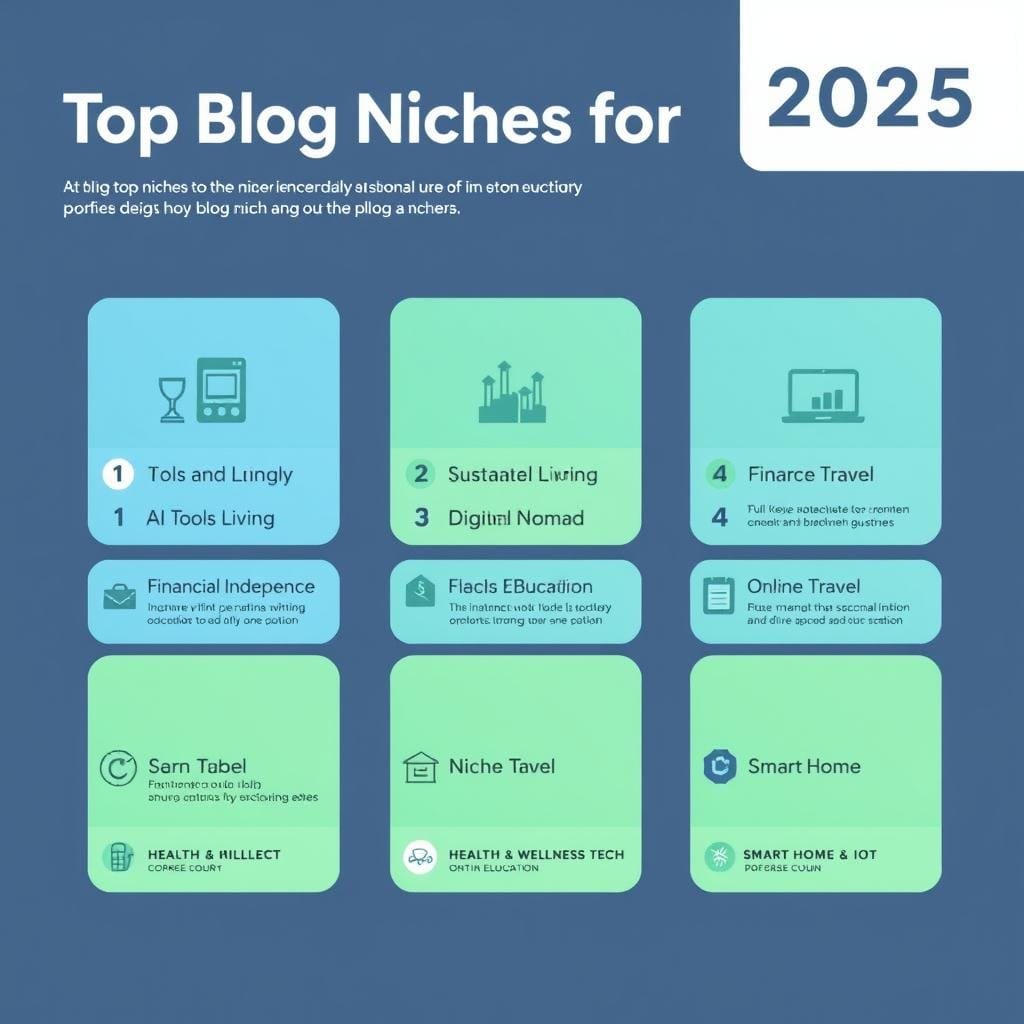
Top Blog Niches for 2025
- AI Tools & Technology: With artificial intelligence transforming every industry, blogs focusing on AI applications, tools, and resources are seeing massive growth.
- Sustainable Living: As climate concerns grow, blogs about eco-friendly products, zero-waste lifestyles, and sustainable practices are gaining traction.
- Remote Work & Digital Nomad Lifestyle: The work-from-anywhere trend continues to expand, creating demand for content about remote work tools, digital nomad destinations, and online career development.
- Financial Independence: Personal finance, investing, side hustles, and financial freedom strategies remain evergreen topics with strong monetization potential.
- Health & Wellness Technology: The intersection of health, wellness, and technology offers numerous blogging opportunities, from fitness trackers to mental health apps.
How to Validate Your Niche Idea
Before diving in, it’s important to validate that your chosen niche has both audience interest and monetization potential. Here’s a simple three-step process:
- Check search volume: Use tools like Ahrefs, SEMrush, or even Google’s free Keyword Planner to see if people are searching for topics in your niche. Look for keywords with at least 1,000-5,000 monthly searches.
- Analyze competition: Study successful blogs in your potential niche. If there are established blogs making money, that’s a good sign there’s a market. However, if there’s virtually no competition, it might indicate limited interest.
- Identify monetization opportunities: Look for affiliate programs, potential digital products, or sponsorship opportunities related to your niche. The presence of these indicates monetization potential.
Find Your Perfect Niche Today!
Still unsure which niche is right for you? I’ve created a free Niche Selection Worksheet that walks you through finding the perfect intersection of your passions and profit potential.
Step 2: Pick a Blogging Platform
Once you’ve chosen your niche, the next step is selecting the right platform to build your blog. This decision is crucial as it affects everything from your site’s design to its monetization capabilities and SEO potential.
Best Blogging Platforms in 2025
While there are numerous blogging platforms available, three stand out as the top choices for bloggers looking to make money in 2025:
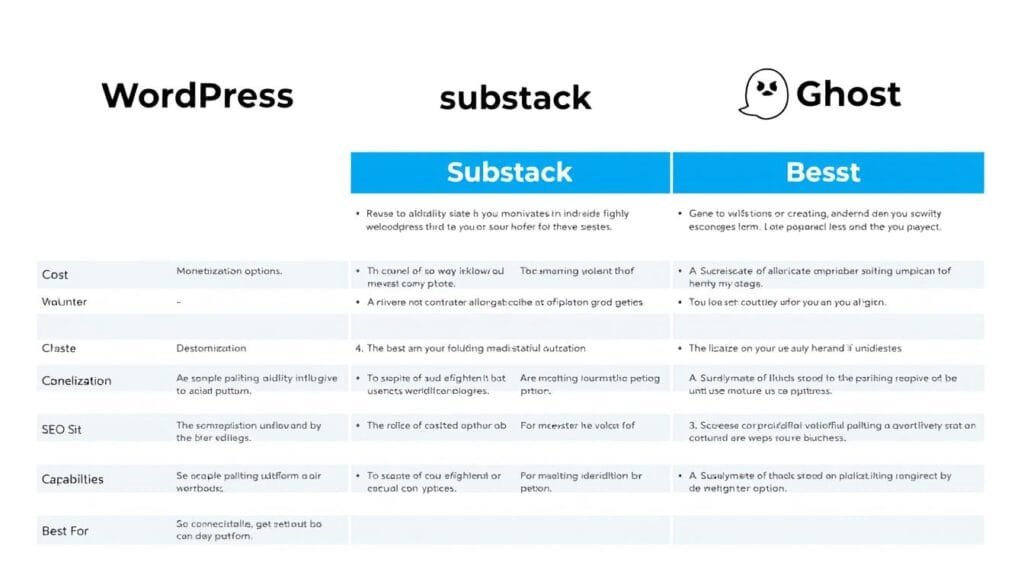
WordPress vs. Substack vs. Ghost: Comparing Top Blogging Platforms for 2025
| Platform | Pros | Cons | Best For |
| WordPress.org | Complete ownership, unlimited customization, powerful SEO capabilities, thousands of plugins and themes | Steeper learning curve, requires separate hosting, maintenance responsibility | Serious bloggers looking to build a business and maximize monetization options |
| Substack | Built-in newsletter and subscription features, simple setup, growing community | Limited customization, Substack takes 10% of subscription revenue, fewer monetization options | Writers focused on subscription models and newsletter-first content |
| Ghost | Clean design, built for professional publishers, membership/subscription features | More expensive than WordPress, fewer themes and plugins | Professional publishers who want a clean, modern platform with membership features |
Why WordPress Is Still the Best Choice for Monetization
While each platform has its merits, WordPress.org (self-hosted) remains the gold standard for bloggers serious about making money. Here’s why:
- Complete ownership: You own your content and your platform, with no risk of the platform changing rules or shutting down.
- Unlimited monetization options: From display ads to affiliate marketing, digital products, and memberships—WordPress supports all monetization methods.
- Superior SEO capabilities: WordPress offers unmatched SEO tools and plugins that help your content rank higher in search engines.
- Endless customization: With thousands of themes and plugins, you can create exactly the blog you envision.
- Scalability: As your blog grows, WordPress grows with you, supporting everything from simple blogs to complex eCommerce sites.
- Massive community: With WordPress powering over 40% of all websites, you’ll never lack for support, tutorials, or resources.
“After trying multiple platforms, I always come back to WordPress. Nothing else offers the same level of control, customization, and monetization potential—especially for bloggers serious about making money.”
Step 3: Register a Domain & Set Up Hosting
Now that you’ve chosen your niche and platform, it’s time to secure your online real estate. This means registering a domain name (your blog’s address on the internet) and setting up hosting (where your blog’s files will live).
How to Choose the Perfect Domain Name
Your domain name is a crucial part of your blog’s brand identity. Here are some tips for choosing a domain name that will serve you well:
- Keep it simple and memorable: Aim for something easy to spell, pronounce, and remember.
- Include keywords if possible: If relevant to your niche, including keywords can help with SEO.
- Avoid hyphens and numbers: These can make your domain harder to remember and type correctly.
- Choose the right extension: While .com is still preferred, extensions like .co, .blog, or niche-specific ones can work well too.
- Think long-term: Choose a name that will still make sense as your blog evolves and grows.
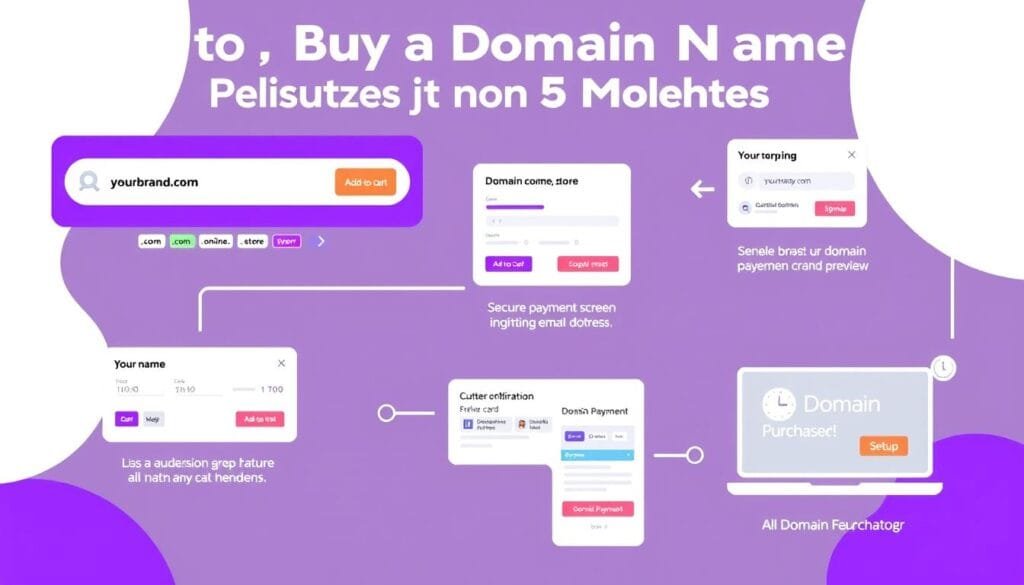
How to Buy a Domain Name in 5 Minutes: A Visual Guide
Selecting the Right Hosting Provider
Your hosting provider is like the foundation of your blog—it affects your site’s speed, reliability, and security. For new bloggers in 2025, these are the top hosting options to consider:
| Hosting Provider | Starting Price | Best Features | Ideal For |
| Bluehost | $2.95/month | Free domain, 1-click WordPress install, 24/7 support | Beginners looking for an all-in-one solution |
| SiteGround | $3.99/month | Superior speed, excellent support, advanced security | Quality-focused bloggers willing to pay slightly more |
| Hostinger | $1.99/month | Budget-friendly, good performance, intuitive interface | Budget-conscious beginners |
| WP Engine | $22.50/month | Managed WordPress hosting, premium performance, advanced security | Professional bloggers with established income |
Setting Up Your WordPress Blog: Quick Start Guide
Once you’ve purchased your domain and hosting, setting up your WordPress blog is surprisingly straightforward:
- Install WordPress: Most hosts offer one-click WordPress installation. Look for this option in your hosting control panel.
- Log in to your WordPress dashboard: Access your new site at yourdomain.com/wp-admin using the credentials from your installation.
- Choose a theme: Select a theme that matches your vision (we’ll cover this more in the next section).
- Install essential plugins: Add functionality with plugins for SEO, security, and performance.
- Configure basic settings: Set up your site title, tagline, and permalink structure.
Get Started with Bluehost Today!
I personally recommend Bluehost for new bloggers. They offer a free domain, one-click WordPress installation, and 24/7 support—all at an affordable price. Plus, as a reader of this blog, you can get a special discount!
Step 4: Design Your Blog
Your blog’s design creates the first impression for your visitors and can significantly impact user experience, engagement, and even your SEO rankings. In 2025, blog design trends are leaning toward clean, minimalist layouts that prioritize readability and user experience.
2025 Blog Design Trends
Stay ahead of the curve with these trending design elements that are dominating the blogging landscape in 2025:
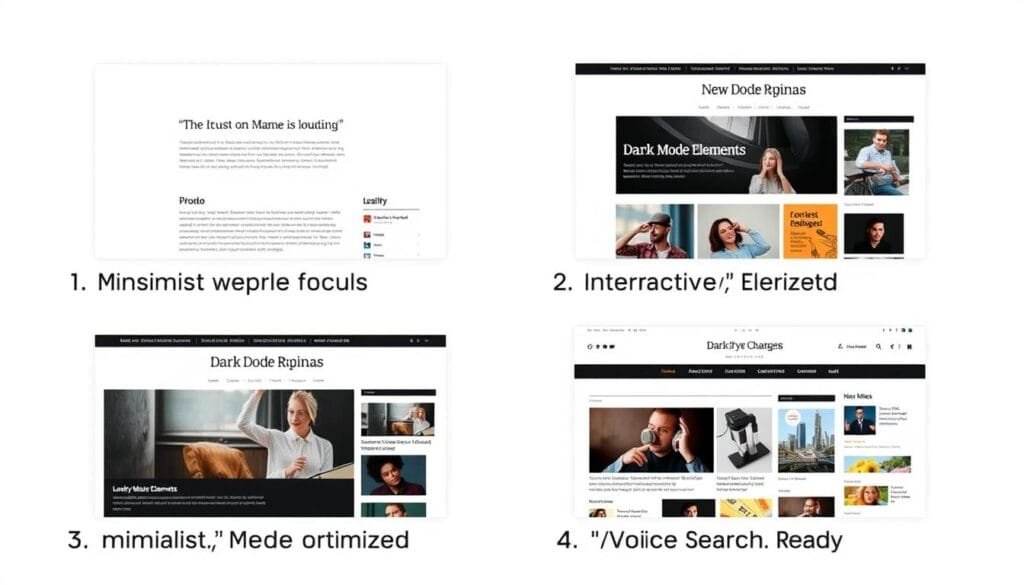
2025 Blog Design Examples: What’s Working Now
- Minimalist layouts: Clean designs with plenty of white space that put the focus on your content.
- Dark mode options: Offering light and dark versions of your blog to accommodate user preferences.
- Micro-interactions: Small animations and interactive elements that enhance user engagement.
- Voice-search optimization: Designs that accommodate voice search with clear headers and structured data.
- Mobile-first approach: Designs that prioritize the mobile experience, where most blog consumption happens.
- Accessibility features: Ensuring your blog is usable by people with disabilities.
- Integrated multimedia: Seamless incorporation of video, audio, and interactive elements.
- AI-enhanced personalization: Dynamic content that adapts based on user behavior and preferences.
Essential WordPress Themes for 2025
Choosing the right WordPress theme is crucial for creating a professional-looking blog. Here are some top themes that combine modern design with functionality:
| Theme | Price | Best Features | Ideal For |
| Astra | Free / $49+ | Lightning-fast, highly customizable, works with all page builders | Beginners and pros alike seeking performance |
| GeneratePress | Free / $59 | Extremely lightweight, SEO-friendly, exceptional performance | Performance-focused bloggers |
| Kadence | Free / $129 | Header builder, hooked elements, custom fonts | Design-conscious bloggers who want flexibility |
| Divi | $89/year | Visual drag-and-drop builder, 800+ pre-made designs | Bloggers who want design control without coding |
Must-Have WordPress Plugins for 2025
Enhance your blog’s functionality with these essential plugins:
- Yoast SEO or Rank Math: Optimize your content for search engines.
- WP Rocket: Speed up your site with advanced caching.
- Wordfence Security: Protect your blog from hackers and malware.
- Elementor: Create custom page layouts with drag-and-drop simplicity.
- ConvertKit or Mailchimp: Build and manage your email list.
- Akismet: Filter out spam comments automatically.
- MonsterInsights: Connect Google Analytics to track your blog’s performance.
- Social Snap or Grow: Add social sharing buttons to increase content distribution.
Pro Tip: Don’t overload your blog with too many plugins, as this can slow down your site. Start with the essentials and add more only as needed. Always check plugin ratings, update frequency, and compatibility with your WordPress version before installing.
Step 5: Create High-Quality Content
Content is the heart of your blog. In 2025, creating high-quality, valuable content is more important than ever as readers and search engines become increasingly sophisticated in recognizing and rewarding excellence.
Content Creation Tools for 2025
Modern content creation involves a blend of human creativity and AI assistance. Here are some cutting-edge tools to enhance your content creation process:
| Tool Category | Top Tools | Best Used For |
| AI Writing Assistants | ChatGPT-5, Jasper, Copy.ai | Generating outlines, overcoming writer’s block, creating first drafts |
| Content Optimization | Surfer SEO, Clearscope, MarketMuse | Optimizing content for search engines while maintaining readability |
| Image Creation | DALL-E 3, Midjourney, Canva | Creating custom images, infographics, and visual elements |
| Editing & Proofreading | Grammarly, ProWritingAid, Hemingway Editor | Polishing content, improving readability, eliminating errors |
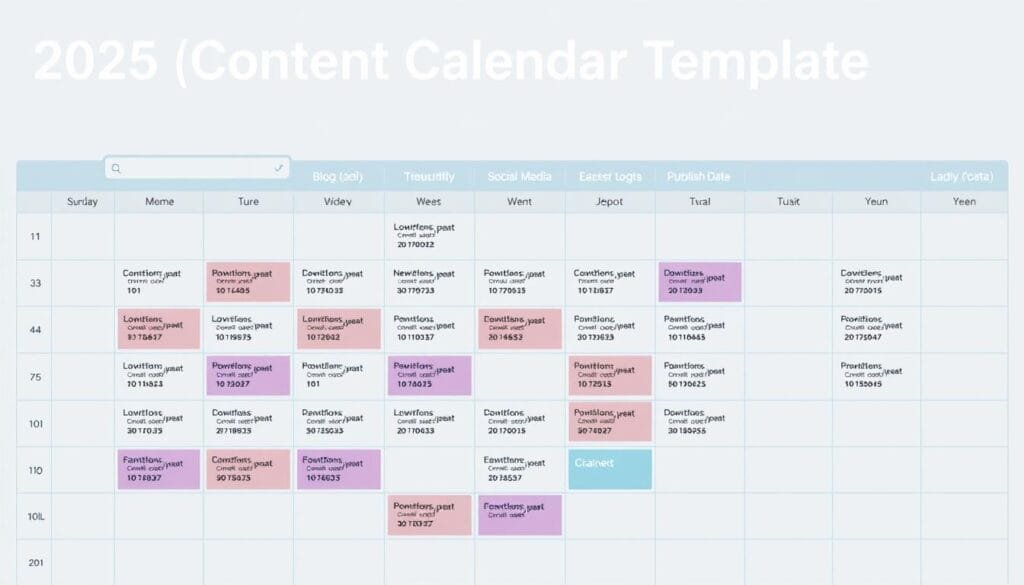
2025 Content Calendar Template: Stay Organized and Consistent
Content Types That Perform Best in 2025
While traditional blog posts still have their place, diversifying your content types can help attract and engage different audience segments:
- Long-form guides: Comprehensive, authoritative content (2,000+ words) that thoroughly covers a topic.
- Video-enhanced posts: Blog posts with embedded video content that caters to different learning preferences.
- Interactive content: Quizzes, calculators, and tools that engage readers and provide personalized value.
- Expert roundups: Compilations of insights from industry experts that leverage their authority and networks.
- Case studies: Real-world examples that demonstrate solutions to specific problems.
- Data-driven content: Original research, surveys, and data analysis that provides unique insights.
- Audio content: Podcast episodes or audio versions of your blog posts for on-the-go consumption.
- AI-curated personalized content: Dynamic content that adapts based on user behavior and preferences.
Creating a Content Strategy That Converts
A strategic approach to content creation will help you attract, engage, and convert readers:
- Define your content pillars: Identify 3-5 main topics that align with your niche and audience interests.
- Conduct keyword research: Use tools like Ahrefs, SEMrush, or Ubersuggest to find keywords with good search volume and manageable competition.
- Create a content calendar: Plan your content in advance, ensuring a consistent publishing schedule.
- Develop a content workflow: Establish a process for ideation, creation, editing, publishing, and promotion.
- Incorporate monetization opportunities: Strategically plan where and how you’ll include affiliate links, product mentions, or lead magnets.
“The secret to creating content that converts isn’t just about what you say—it’s about how well you understand and address your audience’s specific needs, questions, and pain points.”
Never Run Out of Blog Post Ideas Again!
Get my free swipe file of 101 blog post ideas that are proven to drive traffic and generate income. These content templates work across any niche!
Step 6: Optimize for SEO
Search Engine Optimization (SEO) is crucial for driving organic traffic to your blog. In 2025, SEO has evolved significantly, with Google’s algorithms becoming increasingly sophisticated in evaluating content quality, user experience, and expertise.
2025 SEO Best Practices
Stay ahead of the curve with these current SEO strategies:
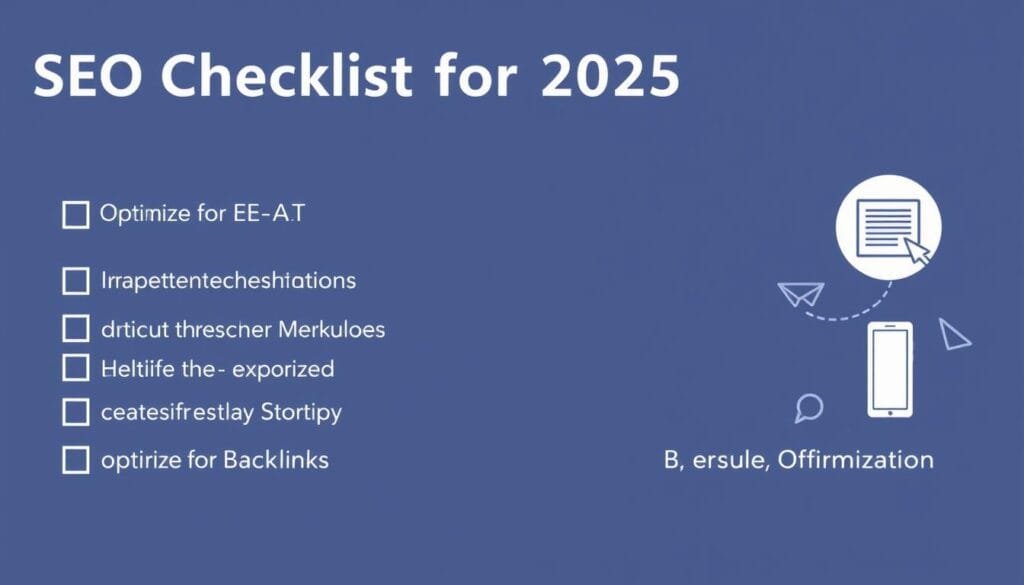
SEO Checklist for 2025 Blogs: Essential Optimization Steps
- E-E-A-T optimization: Google now evaluates content based on Experience, Expertise, Authoritativeness, and Trustworthiness. Include author bios, credentials, and cite reputable sources.
- AI content considerations: While AI-assisted content is acceptable, ensure it’s edited for accuracy, uniqueness, and human touch. Google prioritizes content with “substantial human contribution.”
- Core Web Vitals: Page experience signals like loading performance, interactivity, and visual stability are now major ranking factors.
- Mobile-first indexing: Google primarily uses the mobile version of your site for indexing and ranking.
- Video SEO: With video content consumption at an all-time high, optimizing video content (transcripts, timestamps, structured data) is increasingly important.
- Voice search optimization: Structure content to answer specific questions naturally, as voice searches typically use conversational language.
Essential SEO Tools for Bloggers in 2025
These tools will help you implement effective SEO strategies:
| Tool | Price | Best Features |
| Ahrefs | $99/month | Comprehensive keyword research, competitor analysis, backlink monitoring |
| SEMrush | $119.95/month | All-in-one SEO toolkit, content optimization, position tracking |
| Rank Math Pro | $59/year | WordPress SEO plugin with schema markup, AI content analysis |
| Google Search Console | Free | Performance monitoring, indexing issues, mobile usability |
| PageSpeed Insights | Free | Core Web Vitals analysis, performance optimization suggestions |
Keyword Research Strategy for 2025
Effective keyword research remains the foundation of SEO success:
- Start with seed keywords: Begin with broad terms related to your niche.
- Expand with keyword tools: Use tools like Ahrefs or SEMrush to find related keywords, questions, and long-tail variations.
- Analyze search intent: Determine whether searchers want informational, navigational, commercial, or transactional content.
- Evaluate difficulty and volume: Look for keywords with good search volume but manageable competition.
- Group keywords by topic: Create content clusters around related keywords to establish topical authority.
Pro Tip: In 2025, focus on targeting topic clusters rather than individual keywords. Create comprehensive pillar content supported by related articles to establish topical authority in your niche.
Step 7: Monetization Strategies
Now for the part you’ve been waiting for—how to actually make money from your blog in 2025. The good news is that there are more ways than ever to monetize your content, and many bloggers use multiple streams of income for maximum revenue.
Top Blog Monetization Methods in 2025
Here are the most effective ways to generate income from your blog:
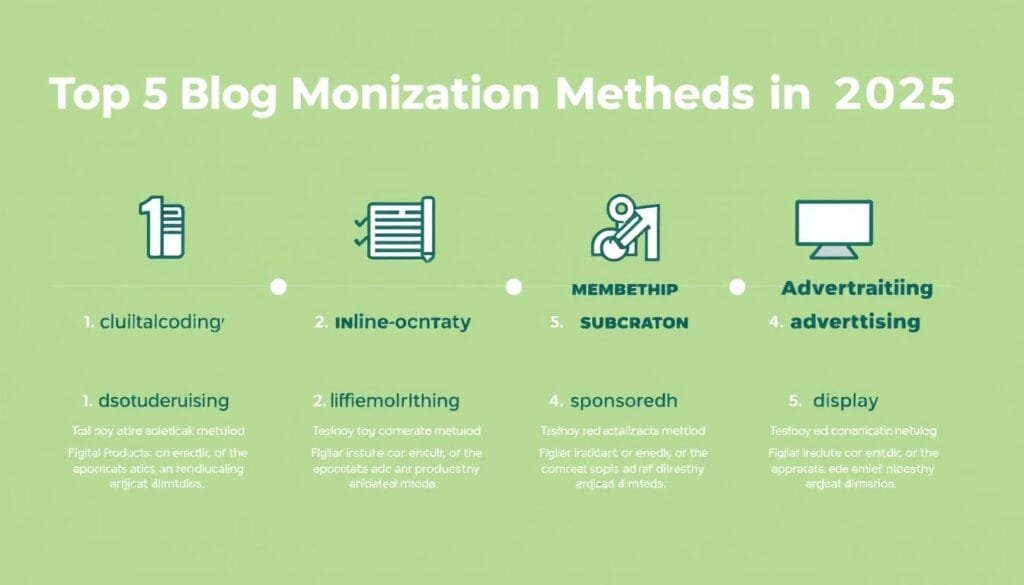
Top 5 Blog Monetization Methods in 2025: Ranked by Profitability
Digital Products & Courses
- Profit Potential: Very High
- Time to First Sale: 3-6 months
- Traffic Needed: Low to Medium
- Best For: Bloggers with specific expertise
- Examples: Online courses, ebooks, templates, printables
- Key Benefit: 100% profit margin after creation
Affiliate Marketing
- Profit Potential: High
- Time to First Sale: 1-3 months
- Traffic Needed: Low to High
- Best For: Product-focused niches
- Examples: Amazon Associates, ShareASale, impact.com
- Key Benefit: No product creation or customer service
Membership & Subscriptions
- Profit Potential: High
- Time to First Sale: 6-12 months
- Traffic Needed: Medium
- Best For: Established bloggers with loyal audiences
- Examples: Premium content, communities, coaching
- Key Benefit: Recurring revenue model
Sponsored Content
- Profit Potential: Medium to High
- Time to First Sale: 6-12 months
- Traffic Needed: Medium to High
- Best For: Blogs with engaged audiences
- Examples: Sponsored posts, reviews, social media
- Key Benefit: High one-time payments
Display Advertising
- Profit Potential: Low to Medium
- Time to First Sale: 1-3 months
- Traffic Needed: High
- Best For: High-traffic blogs
- Examples: Google AdSense, Mediavine, AdThrive
- Key Benefit: Passive income with minimal effort
Services & Consulting
- Profit Potential: High
- Time to First Sale: 1-3 months
- Traffic Needed: Low
- Best For: Expertise-based blogs
- Examples: Coaching, consulting, freelancing
- Key Benefit: Highest per-client value
How to Implement Affiliate Marketing Successfully
Affiliate marketing remains one of the most accessible monetization methods for new bloggers. Here’s how to do it right:
- Choose relevant products: Only promote products that align with your niche and that you genuinely believe in.
- Join reputable affiliate programs: Start with Amazon Associates, ShareASale, or affiliate programs specific to your niche.
- Create valuable content: Product reviews, comparisons, tutorials, and resource lists work well for affiliate promotion.
- Disclose relationships: Always disclose your affiliate relationships to maintain trust and comply with FTC guidelines.
- Use tracking links properly: Implement a plugin like ThirstyAffiliates to manage and cloak affiliate links.
- Focus on high-converting placements: Strategic placement within content often converts better than banner ads.
“The most successful monetization strategy isn’t about choosing one method—it’s about building multiple income streams that work together. Start with one, master it, then add another.”
Ready to Monetize Your Blog?
Get my free Monetization Roadmap that shows you exactly when and how to implement each income stream for maximum results—even if you’re just starting out.
Step 8: Promote Your Blog
Creating great content is only half the battle—you also need to get it in front of your target audience. In 2025, blog promotion strategies have evolved significantly, with social media algorithms, SEO, and content distribution channels all playing crucial roles.
Traffic Generation Strategies for 2025
Here are the most effective ways to drive traffic to your new blog:
Viral Blog Promotion Tactics for 2025: Drive Traffic to Your Blog
Social Media Strategies
- TikTok & Instagram Reels: Create short-form vertical videos that tease your blog content.
- Pinterest SEO: Optimize pins with keywords, create multiple pin designs per post.
- Twitter threads: Break down blog posts into engaging tweet threads with a link to the full post.
- LinkedIn articles: Repurpose blog content as LinkedIn articles for professional topics.
Community Building
- Email marketing: Build an email list from day one to have a direct line to readers.
- Online communities: Participate in relevant Facebook groups, Reddit subreddits, and Discord servers.
- Collaborations: Partner with other bloggers for guest posts, interviews, or joint projects.
- Podcast appearances: Be a guest on podcasts in your niche to reach new audiences.
SEO Traffic Strategy
While social media can drive immediate traffic, SEO provides sustainable long-term growth:
- Focus on low-competition keywords: As a new blogger, target long-tail keywords with lower competition.
- Create comprehensive content: Aim to create the most thorough resource on your chosen topics.
- Build quality backlinks: Earn links from reputable sites in your niche through guest posting, HARO, or creating link-worthy content.
- Optimize for featured snippets: Structure content with clear questions and concise answers to win position zero.
- Update content regularly: Refresh older posts with new information to maintain relevance and rankings.
Email Marketing for Bloggers
Building an email list should be a priority from day one:
- Create compelling lead magnets: Offer valuable free resources (checklists, templates, mini-courses) in exchange for email addresses.
- Place opt-in forms strategically: Add forms to your homepage, within content, in your sidebar, and as exit-intent popups.
- Segment your list: Group subscribers based on interests or behavior to send more targeted content.
- Automate email sequences: Create welcome series and automated follow-ups to nurture new subscribers.
- Provide exclusive value: Give subscribers content or offers they can’t get elsewhere to maintain engagement.
Pro Tip: Don’t try to be everywhere at once. Choose 2-3 promotion channels that align with where your target audience spends time, and focus on mastering those before expanding to others.
Ready to Start Your Blog and Make Money in 2025?
Starting a blog in 2025 is an exciting journey with tremendous potential for both creative expression and financial reward. By following the steps outlined in this guide—choosing a profitable niche, setting up on the right platform, creating valuable content, optimizing for SEO, implementing smart monetization strategies, and promoting effectively—you’re well on your way to building a successful blog.
Remember that blogging is a marathon, not a sprint. The most successful bloggers are those who consistently create value, adapt to changes, and persist through the inevitable challenges. With dedication and the right strategies, your blog can become a significant source of income and impact in 2025 and beyond.

The best time to start a blog was 5 years ago. The second best time is today.
Get My Complete Blogging Blueprint
Want to fast-track your blogging success? Join my free 7-day email course where I’ll walk you through setting up your blog, creating content that ranks, and implementing proven monetization strategies—step by step!
Frequently Asked Questions
Is blogging still profitable in 2025?
Absolutely! While the blogging landscape has evolved, it remains highly profitable for those who approach it strategically. In fact, with the creator economy projected to reach half a trillion dollars by 2027, there are more opportunities than ever to monetize a blog. The key is to focus on providing genuine value, building an engaged audience, and diversifying your income streams.
How long does it take to make money from a new blog?
The timeline varies depending on your niche, content quality, promotion efforts, and monetization methods. Some bloggers make their first dollars within 1-3 months through affiliate marketing or offering services. However, building substantial income typically takes 6-12 months of consistent effort. For most successful bloggers, reaching a full-time income takes 18-24 months of dedicated work.
How much does it cost to start a blog in 2025?
You can start a blog for as little as $3-5 per month for hosting, plus about $12-15 per year for a domain name. This minimal investment of around $50-75 for your first year is all you need to get started. As your blog grows, you might choose to invest in premium themes ($50-100), essential plugins ($0-200), and marketing tools ($0-100 monthly), but these are optional and can be added gradually as your blog begins generating income.
Is it too late to start a blog in my niche?
It’s never too late to start a blog in any niche. While some niches are more competitive than others, there’s always room for fresh perspectives, unique voices, and new approaches. The key is to find your unique angle or sub-niche within broader topics. Focus on serving a specific audience segment better than anyone else, and you’ll find your place even in crowded markets.
Do I need to be a tech expert to start a blog?
Not at all! Modern blogging platforms like WordPress have made it incredibly user-friendly to start and manage a blog without any coding or technical knowledge. With one-click installations, drag-and-drop builders, and thousands of pre-made themes and plugins, anyone can create a professional-looking blog. If you can use basic word processing software, you have all the technical skills needed to start blogging.










